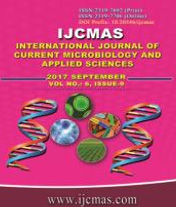


 National Academy of Agricultural Sciences (NAAS)
National Academy of Agricultural Sciences (NAAS)

|
PRINT ISSN : 2319-7692
Online ISSN : 2319-7706 Issues : 12 per year Publisher : Excellent Publishers Email : editorijcmas@gmail.com / submit@ijcmas.com Editor-in-chief: Dr.M.Prakash Index Copernicus ICV 2018: 95.39 NAAS RATING 2020: 5.38 |
The present study was conducted on stratified random sampling in five talukas of Navsari district, Gujarat, India to evaluate the productivity and carbon sequestration under prevalent agroforestry systems during 2011-12. Agroforestry practices such as Agri-silvi-horticultural systems (ASHS) Agrisilvicultural systems (ASS), Agri-horticultural systems (AHS), and Silvopastural systems (SPS). Data records showed that AHS had maximum three practices Mango + Sapota + Lemon + Coriander, Mango + Cabbage, Mango + Rice followed by ASS representing two system types i.e. Teak + Sugarcane and Eucalyptus + Spider lily. ASHS and SPS had only one system type i.e. Mango + Teak + Brinjal and Sapota + grass, respectively. Besides these ASS was represented by two more system types (Teak + Rice and Arjun + Nagali) however these system types were found existing with only one farmer. The data of biological and economical yield, carbon sequestration was collected in one cropping season and was analysed to find out the economic viability. Among woody perennials, eucalyptus, under Eucalyptus + Spider lily, gave significantly higher woody biomass. Among intercrops under different agroforestry systems, sugarcane under ASS (Teak + Sugarcane) system gave maximum biomass. Total biological yield was higher from ASS and minimum was in AHS. Among seven agroforestry system types, highest carbon tonnes per hectare (tree + intercrop) was sequestered by ASS system. Most viable agroforestry system on the basis of NPV (Net Present Value), Benefit Cost Ratio (BCR), Equivalent Annual Income (EAI) and compounded revenue was ASH system followed by AHS.
 |
 |
 |
 |
 |